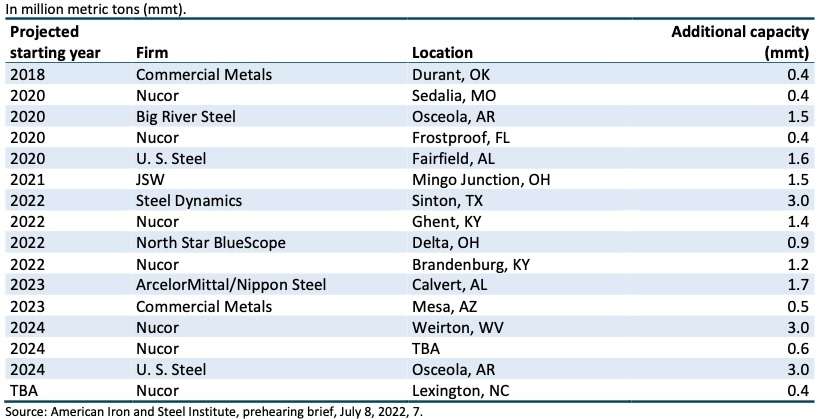In recent weeks, we have seen a barrage of attacks against Donald Trump’s new tariff proposals as he campaigns for the presidency. The criticism comes from journalists, business figures, and economists. They aim not just at new Trump proposals like the 60% tariff on all imports from China, but the track record of the 2018/2019 Trump tariffs which have been largely continued by President Biden. Don’t be fooled. These attacks are wrong and bad economics. They use misleading or fabricated information and draw false conclusions.
The steel and washing machine tariffs have made a powerful contribution to rebuilding those industries and created thousands of jobs. The Section 301 China tariffs have brought some manufacturing production back to the U.S. They have also initiated a process of decoupling the U.S. from China. China’s exports fell 4.6% last year, despite the growth in its exports reaching the U.S. indirectly (via Mexico and Vietnam for example).
Make no mistake: much more is needed to truly restore U.S. self-reliance and domestically-generated prosperity. The Inflation Reduction Act’s tax credits are also a step in the right direction, with a potent stimulus for investment in targeted industries. They should be combined with more aggressive import restriction, especially in industries that China dominates like solar module production, to allow U.S. production to expand more aggressively. There should also be a stronger focus on supporting the development of homegrown products and technologies especially in the upstream part of the supply chain, such as batteries and mineral refining for electric vehicles (EVs).
A typical attack on tariffs was contained in a Wall Street Journal article, Trumponomics 2.0 which claimed that the tariffs produced “disarray” in international business. This article and a similar one in the Financial Times reflected the views of executives at large global corporations who would prefer to maintain their production in a low-wage country like China and remain untroubled by the dangers of excessive dependence on China and the depressing effect on U.S. wages especially of workers without college degrees of competition with low-wage countries.
These articles repeated the false claim of higher consumer prices due to tariffs. Hard for these critics to accept, consumer price inflation actually fell after the Trump tariffs, from 2.4% in 2018 to 1.8% in 2019. In the wake of the Covid pandemic, inflation took off as supply chain snafus and shipping difficulties made goods hard to get. At that point, more tariffs and more domestic production would have helped hold down inflation.
Noted economists David Autor and Gordon Hanson made a more complex argument with two other economists in a new academic article, Help for the Heartland, The Employment and Electoral Effects of the Trump Tariffs in the United States. This article used regionally-based statistical analysis to argue that the Trump tariffs did not increase employment in the tariffed industries, while retaliation by China against U.S. farmers did reduce farming community income, and that reduction was offset by the Trump administration’s compensation program.
Yet when one looks more closely at the analysis, the details argue for the opposite to what the headline claims. The study breaks the U.S. down into 722 “commuting zones” with detail on employment by industry in each one. It tracks the weight of the tariffed industries in each zone and the changes in employment over the two years 2018 and 2019. While their first statistical analysis found no significant relationship between the tariffs and employment in the protected industries, their more detailed analysis did find such a relationship.
The zones which had more employment in the protected (manufacturing) industries had a long-term pre-existing decline in manufacturing employment. Once the authors corrected for that pre-existing trend, the statistical analysis found that tariffs did indeed contribute to rising employment in zones with relatively larger presence in protected industries. “With the addition of these controls, the estimated effect of import tariffs on employment rates turns from negative to modestly positive,”[1] the report said. This finding shows that even across the entire nation and within only first two years of implementing the tariffs, there was a measurable increase in employment in the targeted industries.
The fact that this one study contains two conflicting results demonstrates that statistical analysis of the kind favored by academic economists these days is not a terribly reliable indicator of economic relationships in the real world. In this case, the study dilutes the effects of tariffs by looking at its effects across the whole country and across the entire employment base. Tariffs are by their nature targeted policies whose effects should be judged based on the targeted industries.
The authors’ finding that China’s retaliatory tariffs had a more significant economic impact on incomes in zones exposed to agriculture makes sense because zones exposed to those industries tend to be more heavily concentrated in agriculture, whereas the U.S. tariffs on China were spread across hundreds of types of products.
The main virtue of this study is that it uses once again the regional (“commuting zone”) based analysis that Autor, Dorn, Hanson and their colleagues pioneered. This so-called “China Shock” research[2] presented the first analysis attributing U.S. manufacturing job loss to China imports that was widely accepted by the academic community. In effect, it provided an escape from the rigid “trade is always good” dogma that U.S. economists have preached since the start of hyperglobalization thirty years ago. This study is a sort of “marketing” effort, to reinforce the appeal of regional analysis of trade policies among economists. The largely anti-tariff findings must be set in the context of a series of China Shock papers which found strongly negative impacts for the U.S. from trade with China.
We have discovered that single-country tariffs, such as the Section 301 tariffs on China, lead to a rapid flight of multinational investment and production to other low-wage countries, principally in Asia plus Mexico. They are less successful at reshoring production back to the U.S. Global tariffs, such as those on steel, have been more effective at stimulating reshoring of industry to the U.S., investment, and job creation.
Nevertheless, the China tariffs have led to significant reshoring in certain industries. Examples include: generator manufacturer Generac moved the production of home generators from China to Trenton, South Carolina in 2021, hiring 750 employees at the plant. GE Appliance (today owned by Chinese multinational Haier) moved the production of four-door refrigerators from China to Louisville, Kentucky, also in 2021. That move created 245 additional jobs in the Louisville facility. Finally, furniture maker Williams Sonoma expanded its Tupelo, Mississippi facility with the creation of 350 additional jobs, to produce upholstered furniture that had been produced in China. For its quick response to the China tariffs, Williams Sonoma (which also owns Pottery Barn and West Elm furniture makers) was recognized for “Resilience Plan of the Year” by a supply chain industry publication. Between 2017 and 2023, Williams Sonoma’s profit more than tripled, from $309 million to $950 million.
The global steel tariffs of 2018 led to a boom in investment and the creation of over 4,000 new jobs.
The tariffs gave the industry the confidence to invest in new steel plants. Figure 1 was compiled by the bipartisan U.S. International Trade Commission. It shows that the industry has initiated and in many cases begun production at more than 15 new steel plants all over the U.S., with capacity of some 10 million tons. In each case, these new plants use the latest most efficient, cleanest technology, upgrading the level of our steel industry.
Figure 1. New steelmaking facilities initiated since 2018 is the largest growth in the industry in half a century.
 Source: USITC
Source: USITC
These new plants are creating thousands of good-paying jobs all over the U.S. The great virtue of many manufacturing industries is that they offer above-average incomes to their employees, including the large percentage of employees who don’t need a college degree for these jobs.
Table 1 shows the high level of incomes earned by today’s steelworkers. According to SEC filings, the median earnings of a steelworker at the top four U.S. steel companies rose by 52.5% between 2017 and 2022. Last year these workers earned on average $135,188 each.
Many other manufacturing sectors would also pay six-figure incomes to employees if they were protected from low-wage import competition and free to grow to meet domestic demand.
Table 1. Industry pay among the steel majors rose 52% in just five years.
| Employee Count | Median Employee Pay | |||||
| 2017 | 2022 | Change | 2017 | 2022 | Change | |
| Nucor | 22,672 | 26,288 | 15.9% | $ 87,753 | $ 124,199 | 41.5% |
| Steel Dynamics | 7,618 | 9,075 | 19.1% | $ 93,695 | $ 140,649 | 50.1% |
| US Steel | 27,637 | 23,141 | -16.3% | $ 72,635 | $ 143,684 | 97.8% |
| Cleveland Cliffs (*) | 28,968 | 24,611 | -15.0% | $ 100,501 | $ 132,220 | 31.6% |
| Totals | 86,895 | 83,115 | -4.4% | $ 88,646 | $ 135,188 | 52.5% |
| Note: (*) Cleveland Cliffs 2017 employment figure includes employees acquired in AK and Arcelor-Mittal acquisitions. | ||||||
| Source: SEC filings | ||||||
The table shows that while two companies (Nucor and Steel Dynamics) grew strongly in this five-year period, the two older steel companies (U.S. Steel and Cleveland Cliffs) reduced their headcounts. This highlights an important point about tariffs and other industrial policies. The goal of these policies is, or should be, not to save every single existing job. We do not want to freeze and preserve the past. The goal must be to maintain the strength of valuable U.S. industries and enable them to grow. The older steel companies are burdened with older steelmaking technology and higher costs. The tariffs are actually helping them make the transition to newer, cleaner, lower-cost technology. This is bad news for workers at the older facilities but good news for the entire industry and good news for the industry’s customers such as the auto industry.
Tariffs and other industrial policies must aim at ensuring that there are enough strong, growing, high-paying industries to lift incomes across all regions and all income classes in America.
I have written recently about how the 2018 Section 201 washing machine tariffs had similar investment and job-growth effects as steel. By attracting two Korean manufacturers (LG Electronics and Samsung) to open new greenfield manufacturing facilities here, the U.S. got the best of all worlds: more jobs, more competition, and more new factories building washing machines, while prices did not rise.
Economists are recognizing, slowly but irresistibly, that tariffs and other industrial policies are essential in a world of low travel costs, large wage differences, and nations like China willing to deploy any and every beggar-thy-neighbor policy trick to increase their trade surplus. Journalists and multinational executives are slower to acknowledge reality but it will come.
Notes
[1] David Autor, Anne Beck, David Dorn, Gordon H. Hanson, Help for the Heartland, The Employment and Electoral Effects of the Trump Tariffs in the United States, NBER Working Paper 32082, pg. 13.
[2] See www.chinashock.info and in particular the most impactful China Shock paper, Import Competition and the Great U.S. Employment Sag of the 2000s (January 2016).













